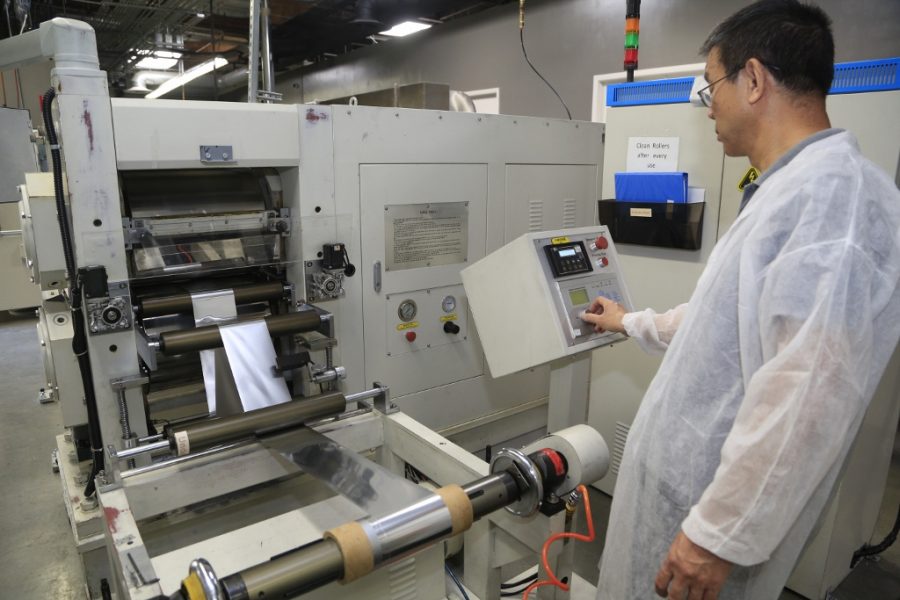Creating a lithium ion battery that won’t catch fire
A technician monitors battery production at American Lithium Energy’s facility in Carlsbad, Calif. The company makes batteries mostly for the military. (David Brooks/San Diego Union-Tribune/TNS)
April 4, 2017
SAN DIEGO — At American Lithium Energy’s headquarters outside San Diego, President and co-founder Jiang Fan opens a padlocked door to the company’s battery testing chamber.
Here, squat machines puncture batteries with nails, crush them with a weight and pump so much voltage into them during recharging that they swell like miniature balloons.
This abuse could spark explosions or fires in typical lithium-ion batteries. Yet American Lithium’s cells don’t blow up or ignite. They’re misshapen but harmless.
The small company, which mostly supplies batteries to the U.S. military, believes it has come up with technology to improve safety in rechargeable lithium-ion batteries — the power source for a growing number of electronic gadgets ranging from cellphones to laptops to electric cars to home energy storage.
The technology, branded Safe Core, is complicated, and Fan isn’t revealing many details. But Safe Core stems from a U.S. Department of Energy project to deliver high-energy electric vehicle batteries that won’t catch fire in a crash, and it has been applied to wearable bullet safe batteries for soldiers.
“What we did was put a fuse inside the cell, so when something is wrong inside, our fuse will kick in and break the current and then the battery will be safe,” said Fan, who has doctorate in solid state chemistry from Arizona State University.
Though rare, reports of lithium-ion batteries bursting into flames have made headlines over the years — most recently with Samsung’s Galaxy Note 7. The South Korean electronics giant spent $5.3 billion recalling the flagship smartphone, which became infamous at airports as passengers heard announcements for months that the Note 7 wouldn’t be allowed on-board.
American Lithium, which has delivered more than 20,000 batteries to Department of Defense customers since 2011, recently spun out a new company called Amionx to commercialize Safe Core technology. It has two patents issued and four pending. It hopes to license the technology for use in lithium-ion batteries globally.
The company isn’t alone in trying to make lithium-ion batteries safer. Several startups and research labs are working on new techniques — including using solid materials that are less volatile than those used in today’s lithium-ion batteries.
But that transition to next-generation batteries likely is still likely several years away. American Lithium contends its technology can be rolled out in existing battery production lines in as little as six months without a significant increase in capital equipment costs or bill of materials expense.
Fan said the company has included the technology in its own battery manufacturing operation for its military customers.
“People who don’t know about this, at first they will probably be skeptical,” said Fan “But when they look at our facility, we have the same facility they have. It is not a lab project. It is at real scale, and it has been validated by the U.S. military.”
American Lithium may be onto something, said Brian Morin, president of Dreamweaver International, a provider of advanced technology for batteries.
“Not having dug into their technology but having read the patent, the concept works,” said Morin, a board member of the National Alliance for Advanced Technology Batteries, a trade group focused on electro-chemical energy storage technology. “Whether the implementation works or not I don’t know. But the concept works.”
Morin added that American Lithium is taking a novel path toward improving battery safety. “There are not 10 other guys trying to do the same thing,” he said. “So if they have made it work, they have something that is a unique approach.”
First brought to market by Sony in 1991, lithium- ion batteries have significant advantages over nickel cadmium in terms of energy density, rapid recharging and cost, according to Tirias Research.
Their chemistry and cell structure, however, present a potential risk of fire, estimated at anywhere from one in a million to one in 50 million.
To mitigate the risk, sophisticated battery management software is used to prevent overcharging and detect problems. Fire retardant chemicals and hardened shells are sometimes included with battery packs to boost safety — though they can hurt performance.
These steps haven’t always worked. In 2013, Boeing was forced to ground all 787 Dreamliners for a few months following a battery fire. In 2006, millions of notebook PCs with Sony lithium-ion batteries were recalled after reported fires.
More recently, a recharging hoverboard has been linked to a house fire in Pennsylvania that killed a 3-year-old girl. A passenger on a flight from Beijing to Australia reported her headphones suddenly began sparking flames before being extinguished by the flight crew.
Many of these failures have been blamed on manufacturing defects.
“The higher quality cells are always better,” said James Kaschmitter, a co-founder PolyStor and now head of research firm SpectraPower. “The reason vape cigarettes and hoverboards go off is they are cheaply made cells.”
The market is growing, driven in part by electric vehicles and the surge in number of smartphones, tablets and other mobile devices. Allied Market Research forecasts that the lithium-ion battery market will grow from $30 billion in 2015 to more than $77 billion by 2024. Telsa is currently building a battery factory, called the Gigafactory, in Nevada that it estimates will eventually produce enough batteries to power 500,000 Tesla cars.
There also is increasing pressure to get more power out of batteries for mobile video and other energy-hungry applications.
“As people try to put more energy into the cell, they end up making compromises,” said Morin. “Each one is just a little compromise in terms of safety, but it makes the whole system less robust. So the level of manufacturing defects (the battery) can withstand is lower.
“You can write it off to manufacturing defects and try to avoid them, but what a lot of people are trying to do is build a more robust system that won’t be as sensitive to manufacturing defects.”
Techniques to boost safety include external cooling shields and other safety systems deployed outside the battery itself. They can confine a failing cell and prevent extreme heat from spreading to other cells in a battery pack.
Startup KULR Technologies has worked with NASA to develop a lightweight, carbon fiber-based heat sink for battery packs. The company has a research and manufacturing center in San Diego. Its technology could be used in electric vehicles, aircraft and industrial energy storage, according to Michael Mo, KULR’s chief executive.
“NASA has been our primary development partner,” said Mo. “They have very strict space constraints and weight constraints. That is the market we are initially targeting, where customers really value weight and space.”
American Lithium’s technology works inside the battery cell itself, killing it when temperature, voltage or current thresholds are exceeded.
“We are trying to make the battery safer from the inside rather than relying on all the outer mechanisms,” said Jenna King, chief executive of Amionx.
Founded in 2006 by Fan and Robert Spotnitz, American Lithium worked on a project to develop a thin, wearable bullet-safe battery that slips into a soldiers’s vest to power communications gear.
In a video from a military test lab, American Lithium’s wearable battery is shot three times with a high powered military rifle. It doesn’t explode or heat up beyond the military’s design threshold.
The company, which has less than 50 workers, believes Safe Core potentially can boost the shelf life of batteries by limiting corrosion. It works not only with lithium ion but other battery chemistries, including emerging solid state configurations.
Retired Qualcomm President Steve Altman, who helped create the mobile giant’s technology licensing arm, is an investor and Chairman of Amionx’s board of directors. The company declined to say how much it has raised to spin out Amionx.
“While fire and explosions caused by lithium-ion batteries are relatively infrequent, the damage when they do occur can be costly and devastating,” Altman said, “including major recalls, damage to brand reputation, personal injuries and even fatalities. The market for Safe Core includes every product application that uses lithium-ion batteries.”








